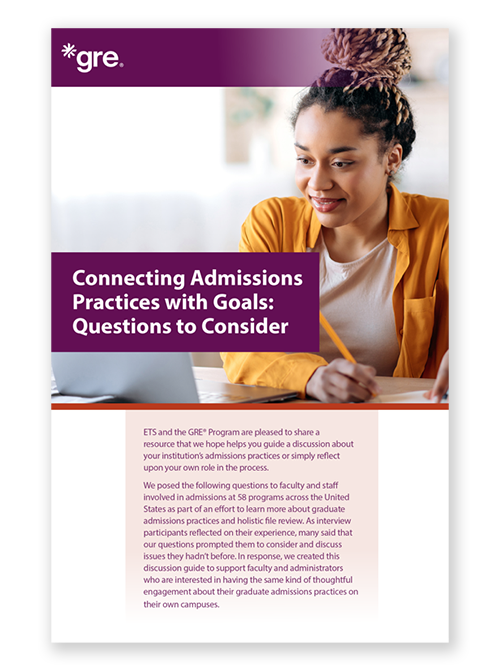Preparing for the Admissions Process
Aligning admissions practices with goals
Are your admissions practices designed to help your program and institution meet their enrollment goals? Adequate preparation can ensure that institutional goals are reflected in admissions practices at the program level.
Prepare: At a glance
- Set goals and guiding principles.
- Structure the recruitment and admissions processes to achieve your goals.
- Consider committee composition and training to mitigate bias in the review process.
Set goals and principles
The goal-setting period is an opportunity for all stakeholders to align on what a successful admissions process looks like for your program. The goals should align with the mission and values of the program and institution and should include details, i.e., demographics, skills and experiences about the desired composition of the admitted student pool.
Establishing guiding principles that align to the core values of the program and institution can help all parties involved understand how the goals will be achieved. For example, a guiding principle might be that all applicants will be evaluated as fairly as possible. Being more specific can help clarify expectations. For example, “All applicants will be evaluated holistically by a team trained in mitigating bias so applicants are selected as fairly as possible.” Once established, the goals and guiding principles can inform every step of the admissions process from recruitment through enrollment.
Structure processes to achieve your goals
Consider what process your program can implement to identify and recruit the desired population. If the program wants to increase enrollment of applicants who meet a certain criteria, ensure that there are processes in place to grow that pipeline, such as building relationships with feeder schools and pipeline programs like the Robert E. McNair Postbaccaleureate Achievement Program and networking with organizations that serve your target audience.
This is also the time to determine how the desired attributes will be assessed, whether the application form is designed to elicit that information, and how each piece of information about the applicant will be weighted given the goal. For example, if the goal is to admit more students with solid research experience, develop specific prompts in the application to elicit that information, perhaps in the personal statement and the letter of recommendation (see how Cornell University Department of Physics and The University of Pennsylvania Wharton School* address this topic). Then determine whether you will give that information greater consideration than other measures, such as undergraduate GPA or test scores. Some institutions use a scorecard or rubric to ensure consistency across reviewers.


Compose and train the committee
Given the faculty committee’s powerful role in the admissions processes, it makes good sense to evaluate the composition of the committee itself to ensure that all members understand the goals, principles and process before the start of the admissions season.
When evaluating the composition of the committee itself, consider whether there is a balance of power among team members to prevent one person from having undue influence over which students are admitted. We are all human, and therefore susceptible to biases. This can be mitigated by ensuring that a variety of perspectives and experiences are reflected in the makeup of the committee membership. Some programs ensure that a representative from the institution’s diversity office participates in the admissions process. Many programs invite one or more current students to provide input into the process and to offer insight about the applications themselves; in some cases, students are voting members of the admissions committee.
A recent report by the Council of Graduate Schools with support from ETS identified training as a key practice that could improve admissions processes. Only 26% of the master’s programs participating in the survey reported that their institutions provide training to those who review applicant files; yet, effective training was identified as essential to admissions success. Researchers noted that a comprehensive faculty development program exploring the most effective admissions review practices could further strengthen the connection between admissions and program success.
In addition to training the committee members about the goals, principles and process, discussing or offering training about the role of implicit (or unconscious) bias and how to avoid it can result in a fairer process overall. Cornell University Graduate School provides an Implicit Bias Resources webpage as a faculty resource, which shares a series of videos produced by the UCLA Office of Equity, Diversity and Inclusion. The resource page also directs visitors to other resources freely available through the Kirwan Institute for the Study of Race and Ethnicity, VMware Women’s Leadership Innovation Lab at Stanford University and Association of American Medical Colleges.
A few promising practices to consider include:
- Promote faculty discussion in advance of each admissions cycle to ensure common understanding of the goals and guiding principles, the admissions process, application review and selection criteria.
- Determine the best approaches to benefit the process and the participants, e.g., optional workshops, mandatory trainings, facilitated conversation about avoiding implicit bias.
Questions to consider
As you prepare for the next admissions cycle, this discussion guide offers questions to consider about your process, from planning through selection to evaluation.
